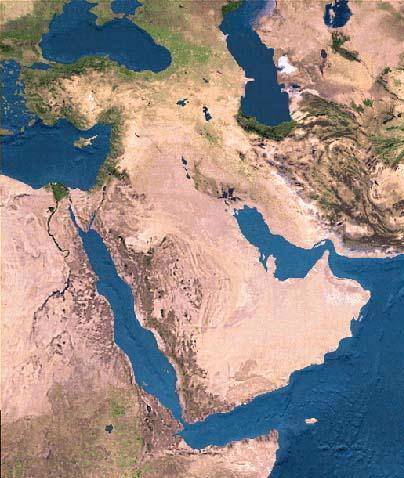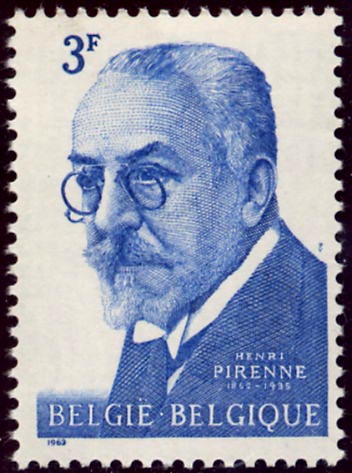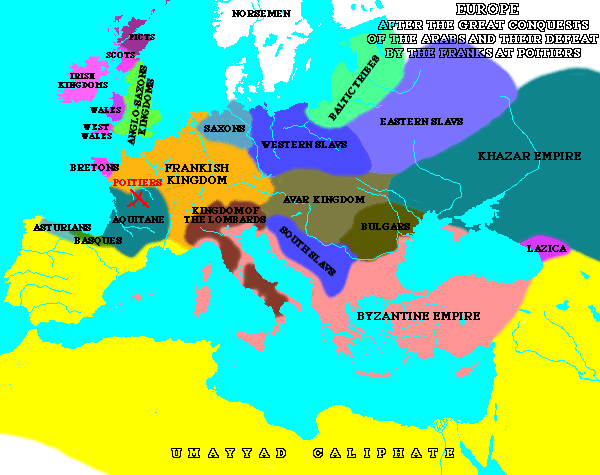The Empire before Islam
As the Islamic movement was beginning, the Byzantine Empire was weakened by:
- Wars with Persia (540 – 629), with intermittent periods of peace.
- The Christological controversies following Chalcedon in 451, which caused widespread disgruntlement, especially among "Nestorians" in Syria and "Monophysites" in Egypt.
- Imperial centralization and bureaucracy which alienated the various peoples subjugated to Constantinople. And
- Financial strains because Justinian had strained the Imperial treasury with his grand building campaigns and his efforts to re-conquer the western Empire, among other things.
The Byzantine Empire's wars with the Sassanian Empire of Persia also exhausted Persia, of course. Arabs would conquer Persia, too, where the Sassanian dynasty ended in 651, twenty years after the death of Muhammad.
Arabia and Islam
 Well under the radar of the Byzantine and Persian Empires, Arabia, a poor desert world that had been inhabited mainly by nomads, was developing commerce (Arabs had been able to domesticate camels), cities (notably Mecca), a cultural identity, and some literature (in the form of Arabic poetry). (Here's a satellite picture of Arabia, a very large peninsula, largely desert, between the Red Sea and the Persian Gulf.)
Well under the radar of the Byzantine and Persian Empires, Arabia, a poor desert world that had been inhabited mainly by nomads, was developing commerce (Arabs had been able to domesticate camels), cities (notably Mecca), a cultural identity, and some literature (in the form of Arabic poetry). (Here's a satellite picture of Arabia, a very large peninsula, largely desert, between the Red Sea and the Persian Gulf.)
Muhammad (c. 570 – 632), a citizen of Mecca, was (we're told) about 40 when he had a religious experience from which there developed the Qur'an, the Islamic scriptures. Like Judaism and Christianity, Islam was a monotheistic religion in which a sacred text had considerable authority, and also like them, it looked back to Abraham as an ancestor.
The conventional summary of the next part of the story goes as follows: Muhammad's religious movement provoked persecution in Mecca, and in 622 he left for a settlement 200 miles to the north, which was later called Medina. This journey, called the hijra or hegira, is dated Year 1 in the Islamic calendar. His movement attracted converts, and Muhammad gathered influence throughout Arabia, including, finally (in 629), Mecca itself.
After Muhammad's death, a series of four "successors" (caliphs) continued to rule from Medina, and their armies conquered part of the Persian empire, Syria, and Egypt. In 661, the caliphate became hereditary under the Umayyad dynasty, which moved the capital of the Islamic empire from Medina to Damascus. This dynasty developed effective armies, and also formed a navy which took control of much of the Mediterranean. It extended its control over territory west of Egypt into North Africa and Spain, and east to the end of the old Persian Empire and into northwestern India. In the territories of the old Roman Empire, it imposed Arabic in the place of Greek and Latin as the language of government and administration.
Some, such as Fred Donner of the University of Chicago (see the link at the left), challenge elements of this story, much of which derive from sources well after the fact. Among other things, he believes that Muhammad's intention wasn't to create a new religion but to renew and energize the monotheistic traditions that he already found in Christianity and Judaism. He doubts that Islam expanded primarily because of its military conquests. He thinks that many in the Byzantine Empire were either swept up in its zeal for religious reform, or they found Arab oversight more congenial than Byzantine oversight.
It's estimated that from the seventh to the eleventh centuries, half the world's Christians lived under Muslim rule.
The mutual impact of Christianity and Islam
The impact of Chritianity on Islam
 The Christian Bible clearly influenced the Qur'an. Mentions of individuals in both the Old and the New Testaments, most prominently Abraham, Mary, and Jesus, give particular evidence of this influence. Many of the general themes of the Christian Bible, such as monotheism, love, and discipleship, are also evident in the Qur'an. John of Damascus, a Christian who criticized Islam, presented it as a Christian heresy.
The Christian Bible clearly influenced the Qur'an. Mentions of individuals in both the Old and the New Testaments, most prominently Abraham, Mary, and Jesus, give particular evidence of this influence. Many of the general themes of the Christian Bible, such as monotheism, love, and discipleship, are also evident in the Qur'an. John of Damascus, a Christian who criticized Islam, presented it as a Christian heresy.
Christians in the territories conquered by the Caliphate influenced the culture, theology, devotion, art, architecture, and science of Islam in various ways. For instance, they made available books of Greek philosophy and science, which thereby became a common heritage of Christianity and Islam. Byzantine architectural forms influenced the Muslim architects who designed mosques. Byzantine mosaic technique influenced Muslim artists. At left, this vegetal pattern from an Egyptian Muslim artist was influenced by earlier Byzantine work. This kind of artwork is an early example of what came to be called arabesque.
The influence of Islam on Christianity
Influences of Islam on Christianity include:
- The realignment of Christian geography. The Middle East and North Africa, fertile areas of Christian life and thought, became largely Muslim.
- Perhaps the rise of the west. (See below for a brief discussion of the Pirenne thesis.)
- Among some Christian theologians, such as John of Damascus, a strategic adaptation of their thought in order to answer the challenges of Islam.
- Among many Byzantine artists, architects, and authors, borrowings of Islamic themes and forms.
- Possibly the eastern Christian movement of iconoclasm, and also the opposing movement of iconophilia, both of which, in different ways, may have been responses to Islamic prohibitions against portraying people in art.
Looking beyond the horizons of the time-frame of this course, we can also see that much of the learning that flowered during the Islamic "golden age", often dated from the late eighth century, later flowed back into Christianity, notably by way of Spain. One exploration of this interchange, from the Metropolitan Museum of Art and Yale University Press, is Byzantium and Islam: Age of Transition.
Christians under Islam
As the Muslim armies conquered new territories, many inhabitants converted in short order, and others felt a continuing pressure to convert over a period of time. But for those individuals resisting conversion, Islamic governments granted a considerable degree of religious freedom. In fact, since non-Muslims paid a special tax, it was in the government's financial interest not to convert everyone. Non-Muslim religious institutions, however, operated under considerable constraints. Thus the titular patriarchs of Antioch and Alexandria felt compelled to live in safe Byzantine territory, from which they could have relatively little influence on their distant dioceses. The numbers of Christians in the Islamic world declined.

The Pirenne thesis
A Belgian historian of the Middle Ages named Henri Pirenne (1862 – 1935) argued that the Islamic conquests, and not the fall of the Roman Empire to the northern "barbarians", created medieval Christian Europe. "Charlemagne without Muhammad is inconceivable," he wrote. The reason: Islamic armies and navies cut eastern Christianity from western. The isolation of the west virtually halted its trade and therefore put an end to urban life and the money economy, creating feudalism, one of the hallmarks of medieval Western Europe. Feudalism didn't require money; wealth resided in land, and society was structured around the exchange of the lord's protection for the vassal's labour and military service. The isolation of the west led the Pope to ally with the Frankish Empire, not the Byzantine Empire, thus creating the foundation for both the medieval papacy and the Carolingian Empire.
The book is currently available on the (legally troubled) Internet Archive.
Pirenne's controversial thesis is seldom accepted in all its details, but it remains provocative, and Pirenne's idea that forces originating in Arabia could have influences in the world of the North Atlantic has received some impetus from recent trends to consider Mediterranean history as a whole.
Peter Brown has written a searching evaluation of the Pirenne thesis, both sympathetic and critical: online access to U of T libraries is required.
Whether Pirenne's thesis about causes is correct or not, it's clear that Christian western Europe was set to grow in wealth, power, and creative vigour while the Christian east was shrinking. It's likely that by about 800, western Christians outnumbered eastern Christians for the first time.
Al-Andalus (Islamic Iberia)
 Muslim leaders and armies began taking control of what we now call Spain in 711, and maintained control until 1492. Most of the military troops were North African Berbers, not Arabs. The territory was called al-Andalus; the etymology of the word is disputed. (Today Andalusia is the name of an autonomous community in Spain, comprising eight provinces, with its capital at Seville.) Muslim attempts to expand into Europe north of the Pyrenees were repelled by Christian Europeans; a battle of 732, sometimes called the Battle of Poitiers and sometimes called the Battle of Tours, is sometimes seen as the turning-point when Muslim momentum flagged and Frankish power proved itself.
Muslim leaders and armies began taking control of what we now call Spain in 711, and maintained control until 1492. Most of the military troops were North African Berbers, not Arabs. The territory was called al-Andalus; the etymology of the word is disputed. (Today Andalusia is the name of an autonomous community in Spain, comprising eight provinces, with its capital at Seville.) Muslim attempts to expand into Europe north of the Pyrenees were repelled by Christian Europeans; a battle of 732, sometimes called the Battle of Poitiers and sometimes called the Battle of Tours, is sometimes seen as the turning-point when Muslim momentum flagged and Frankish power proved itself.
During our period, Muslims remained a minority of the Iberian population, and Arabs remained a minority of the Muslim population. The top officials were Arabs, however. The governors, emirs, and caliphs (as they were successively called), especially after 740, ruled independently of the rest of the Islamic Empire. Islamic Spain advanced agriculturally. prospered economically, and blossomed culutrally, and in the tenth century Córdoba would become the largest city in Europe, with a population variously estimated between 100,000 and 500,000 (more recent estimates tending towards the smaller number). Historians argue about the treatment of Christians, but most now believe that Christians could practice their religion in relative security and that they were integrated into all levels of society. They generally adopted the vocabulary, art, and customs of the dominant culture, and Christians outside the Iberian peninsula called them "mozarabs" or would-be Arabs.